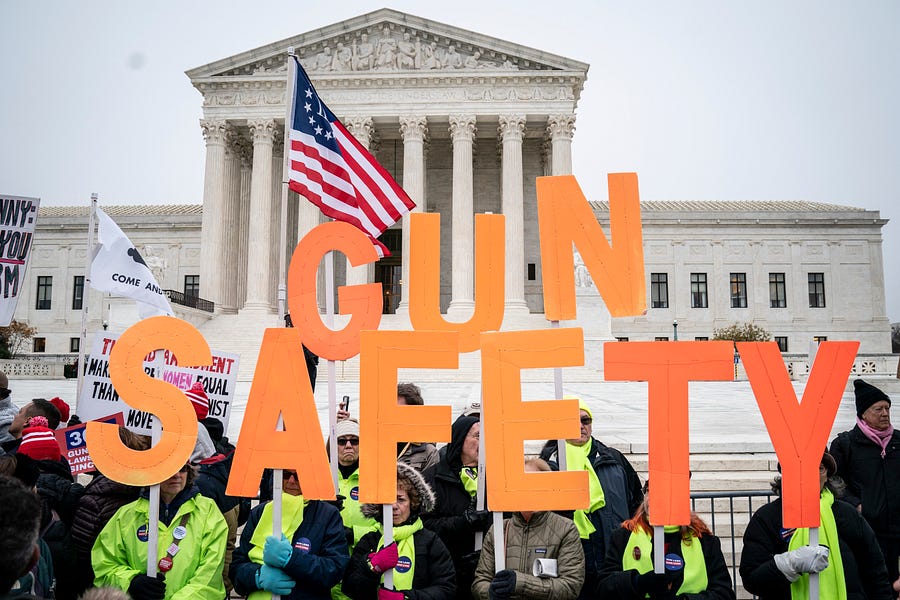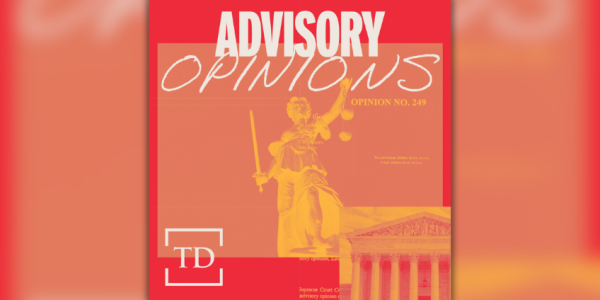Yesterday morning, while sipping coffee, I felt a disturbance in The Force, as if hundreds of civil rights litigators cried out at once. I’ll explain our anguish below. Also, what’s the mark of a flailing Democratic campaign? When they start to go full Beto. Never go full Beto. And finally, what are the missing parts of a New York Times profile of an abortion rights movement in retreat? Today’s French Press:
-
For the first time in more than a decade, SCOTUS hears a gun rights case.
-
Why are flailing Democrats attacking the Constitution?
-
Abortion rights advocates are losing, and the Times doesn’t quite understand why.
SCOTUS has me worried.
Before I dive into the details of yesterday’s oral argument in New York State Rifle & Pistol Association Inc. v. City of New York, New York, it’s important to understand the rather bizarre facts of the case. The city actually banned the transport of a lawfully owned locked, unloaded, licensed handgun outside of the home unless the owner was taking that weapon to one of seven shooting ranges in the city. That meant you couldn’t take it to a second home outside the city. You couldn’t take it on a vacation to a jurisdiction that permitted you to arm yourself.
The law was wildly unconstitutional—representing a direct infringement on the right to “bear” arms, among other things—but that didn’t stop progressive judges at the trial and appellate levels from upholding it against the plaintiff’s challenge. Through years of litigation, the city stood firm.
Then, the Supreme Court took the case, and everything changed. The decision of the court to grant certiorari was something of a surprise. After all, it hadn’t taken a gun rights case in years, and it had declined to hear appeals of far more consequential rulings, including appeals of statewide so-called “assault weapons” bans. But it took this case, dealing with a niche law in a single city.
New York acted. Rather than risk an unfavorable ruling, it did what so many government entities have done before—it tried to moot the case. The city amended its law to permit holders of premises licenses to transport their weapons outside the city, including to second homes or shooting competitions. The state also amended its governing statutes to require cities to permit this transport. The city then filed a document with SCOTUS called a “suggestion of mootness” and asked the court to dismiss the case.
Every civil rights and civil liberties lawyer in America immediately recognized the tactic. It’s a common (and also frequently) effective way in which American governments violate the civil rights of their citizens and then escape accountability entirely—leaving them free to violate those rights again.
To understand how the scheme works, you have to understand how rarely a plaintiff can secure money damages for violations of his constitutional rights. A pernicious, judge-created doctrine called “qualified immunity” protects officials from having to pay for their (constitutional) sins unless the right they violated was “clearly established.” That means that unless you can find another, virtually identical case where a government officer or official was held liable, then courts will dismiss claims for damages. And so law enforcement officers, school officials, or anyone else who violates the law essentially get one free pass. In other instances, damages aren’t available (or substantial) even if qualified immunity doesn’t apply. Courts have had trouble quantifying the financial harm inherent in, say, an act of censorship. Thus, because constitutional harms are either difficult to quantify or subject to qualified immunity, plaintiffs are reduced to seeking injunctive relief, a command from the court striking down an offending law and prohibiting its enforcement.
Government lawyers know their legal advantages and milk them for all their worth. Time and again—during my litigation days—we’d challenge plainly unconstitutional actions and policies, the government (usually a state university) would fight tooth and nail to protect its speech code, and then the instant they sensed a legal loss was imminent, they’d reverse course, change their policies, and file a motion to dismiss the case for mootness. In essence, they’d tell the court, “Move along. Nothing to see here.”
Depending on the circumstances, courts are often wise to the maneuver, and they’ve developed a doctrine holding that they’ll still intervene if the government’s bad act or flawed policy is “capable of repetition,” and the policy change was designed to avoid judicial review. But still, the government gambit often (but not always) works. Plaintiffs can file suit against plainly unconstitutional policies and endure years of scorched-earth legal defenses, only to see governments entirely escape legal accountability with last-minute policy changes that can be easily reversed in the absence of judicial intervention.
New York’s legal changes were obviously designed to evade review. In the absence of a court ruling there would nothing preventing New York from tightening its new laws and then daring a new plaintiff to endure years more of litigation. If there was ever a case begging for Supreme Court intervention in spite of the effort to moot the case, this was it.
And that’s precisely why I found yesterday’s oral argument so troubling. SCOTUSblog’s Amy Howe summarized it like this:
Alito and Gorsuch were the only justices who spoke up as staunchly opposed to dismissing the case as moot. The court’s more liberal justices all seemed inclined to do so, and the only comments that Roberts made suggested that he might be open to doing so as well. Justices Brett Kavanaugh and Clarence Thomas did not ask any questions.
There were relatively few clues as to how the justices might rule on the merits if they decide that the case is not moot, if only because so little of the argument time was devoted to the question of whether the transport ban violated the Second Amendment.
Perhaps it’s my paranoia peeking through. Perhaps I need to remind myself that you can’t read too much into any given oral argument. But the fact that Roberts signaled openness to the city’s mootness argument is deeply troubling, on two counts.
First, if the court rules that the case is moot, it would reaffirm and reinforce SCOTUS’s longstanding reluctance to wade back into Second Amendment jurisprudence. The court has been so passive that Justice Thomas took it to task in a dissent from denial of certiorari, arguing that court inaction was signaling that “the Second Amendment is a disfavored right in this Court.”
Second, and more important, dismissing the case as moot at this late stage could well alter underlying mootness doctrines, granting state defendants in many other kinds of cases (police brutality, speech codes, campus due process), an even greater ability to make last-minute legal changes to avoid legal accountability. This is not an outcome progressives should cheer. It will leave marginalized communities even more vulnerable to state power and less able to hold officials accountable for violations of civil rights.
Again, perhaps I’m too paranoid. Perhaps Justice Roberts is rock-solid and sees through the city’s transparent machinations. I hope that I just wasted 1,000 words of analysis. But until I see the court’s ruling, the oral argument left me more concerned that the Supreme Court just might make an important civil rights mistake.
Kamala Harris and Elizabeth Warren follow the Beto plan.
In the year 2019, how does a flailing Democratic candidate behave? If you’re Beto O’Rourke, and the magic is gone, then you pledge to confiscate weapons and strip churches of their tax exemptions. If you’re Kamala Harris, you say this:
If you’re Elizabeth Warren, and you’re sliding down in the polls, you say this:
It’s a strange sign of the times that Democratic candidates facing headwinds respond by promising wildly disruptive legal (and constitutional) changes that they simply don’t (and won’t) have the power to execute. In so doing, they’re doing two destructive things at once—they’re feeding and stoking an angry, mainly Twitter-based micro-constituency that is seeking truly revolutionary change, and they’re contributing to the idea that modern American politics is an existential death match between two utterly irreconcilable tribes.
Thankfully the strategy hasn’t worked, but if Warren continues to collapse, watch carefully. Will she tack closer to the middle—where she should have been all along—or will she succumb to the temptation that bedeviled many on Kamala Harris’s campaign team?
In the meantime, Beto is now on the sidelines, a living cautionary tale. When the majority of Democratic primary voters are not woke online radicals, doubling down on the issues that makes Twitters’ heart pound is not (yet) the path to the Democratic presidential nomination.
The New York Times misses the impact of the collapsing abortion rate.
On Sunday, the Timesran an extended piece describing how a “divided left” was “losing the battle on abortion.” It cast the challenge to abortion rights like this:
In a six-month period this year, states across the South and Midwest passed 58 abortion restrictions. Alabama banned the procedure almost entirely. Lawmakers in Ohio introduced a similar bill shortly before Thanksgiving. And in March, the Supreme Court will hear its first major abortion case since President Trump added two conservative justices and shifted the court to the right; how it rules could reshape the constitutional principles governing abortion rights.
For abortion opponents, this moment of ascendancy was years in the making. Set back on their heels when President Barack Obama took office, they started methodically working from the ground up. They focused on delivering state legislatures and gerrymandered districts into Republican control. They passed abortion restrictions in red states and pushed for conservative judges to protect them.
And then unexpectedly, and serendipitously, Mr. Trump won the White House. Ending legal abortion appeared within their reach.
That last part is a wild overstatement. Even if Roe is overturned, that would return abortion regulation to the states, and most states protect abortion rights by statute. In fact, overturning Roe would likely lower the abortion rate by only about 13 percent nationwide.
The Times is exactly right, however, to note that the abortion rights movement is on its heels. It highlights, however, the least important reason—the divisions within the abortion rights movement itself. These divisions are interesting (and eye-opening for conservatives who often wrongly view the left as a disciplined ideological monolith), but they’re a rounding error in the long-term trends.
As I wrote in my Thanksgiving newsletter, the abortion rate has been dropping for 39 years. It’s lower than it was when Roe was decided. Through an extraordinary series of complex cultural and legal changes, there is now far less demand for abortions than there was in the decade after Roe was decided, and the best available evidence indicates that the demand will continue to shrink.
The reasons why are complex, intertwined, and hotly disputed. Yes, increased availability of contraception has played a role. Declining rates of teen and young adult sexual activity play a role. The trend toward delayed marriage plays a role. But it’s also true that an increased percentage of women carry unintended pregnancies to term.
At a certain point, a declining abortion rate also can become a self-reinforcing phenomenon. When fewer women abort their babies, there is not only declining demand in the purely commercial sense (rendering the economics of abortion access less viable), there is also less of a sense that abortion is the right, proper, and socially acceptable response to an unplanned pregnancy. It’s just not what people do. In other words, regardless of the reasons for the decline, the decline itself creates its own momentum.
Moreover, the decline shifts the political momentum on the ground. If you look at a map of American abortion rates, you’ll see that most of the states that passed heartbeat bills already had extremely low abortion rates. They’re attempting to ban a practice that’s rare enough that the vast majority of women wouldn’t notice its loss. The culture in their state had moved on. The arc of history had bent away from abortion, and the law looks more like a ratification of a cultural change than an onerous imposition by an oppressive government.
And yes I know there are chicken-and-egg arguments available. Many of the states already had passed other restrictive abortion regulations, but all were subject to the restraints of Roe and Casey, and abortion was fading in spite of federal judicial protection.
Again, I don’t think any person has all the answers for why abortion rates decline, but if the decline continues, even the most united abortion rights movement won’t be able to adjust to the cultural changes to come.
One final thing …
I grew up in Kentucky, but I was born in Opelika, Alabama. My parents are graduates of Auburn University, and it was my love for the Tigers that kept my childhood college football seasons from rising or (mostly) falling on the fortunes of my nearby Wildcats. I remember Bo Jackson. I screamed myself hoarse during the Kick Six. And this weekend, I had reason the cheer yet again. Sorry Alabama fans, there’s a moment we must relive.
War. Eagle.
Photo credit: Gun safety advocates rally in front of the Supreme Court during oral arguments in New York State Rifle & Pistol Association Inc. v. City of New York, New York. (Photo by Drew Angerer/Getty Images)








Please note that we at The Dispatch hold ourselves, our work, and our commenters to a higher standard than other places on the internet. We welcome comments that foster genuine debate or discussion—including comments critical of us or our work—but responses that include ad hominem attacks on fellow Dispatch members or are intended to stoke fear and anger may be moderated.
You are currently using a limited time guest pass and do not have access to commenting. Consider subscribing to join the conversation.
With your membership, you only have the ability to comment on The Morning Dispatch articles. Consider upgrading to join the conversation everywhere.